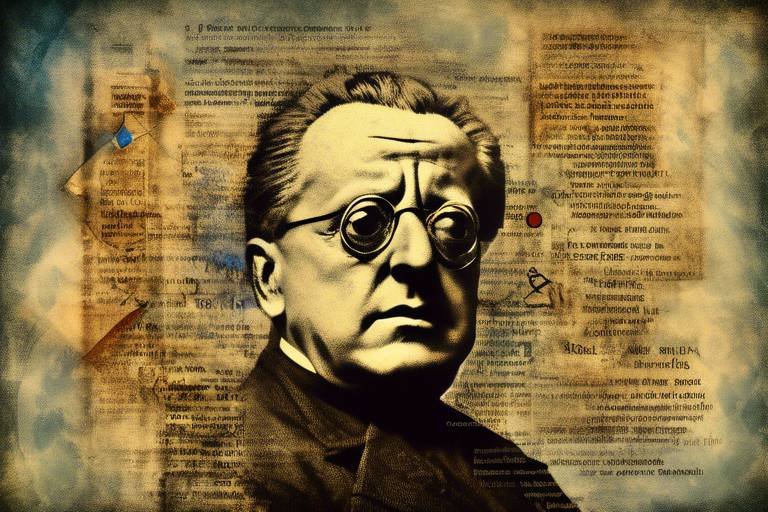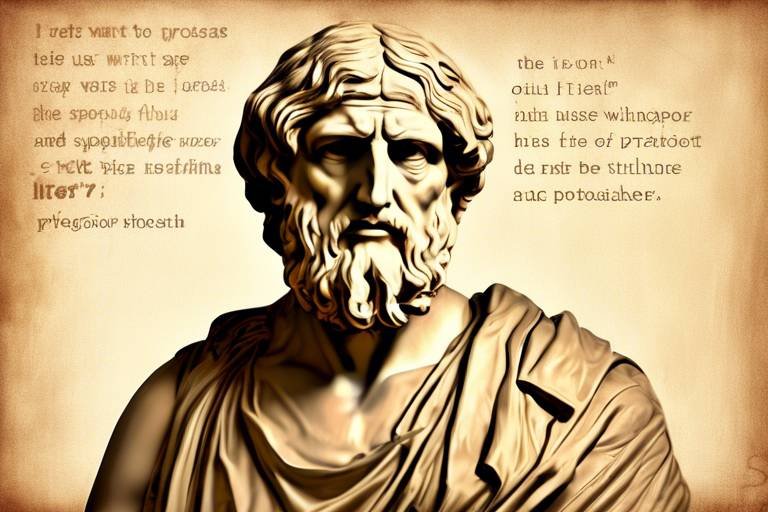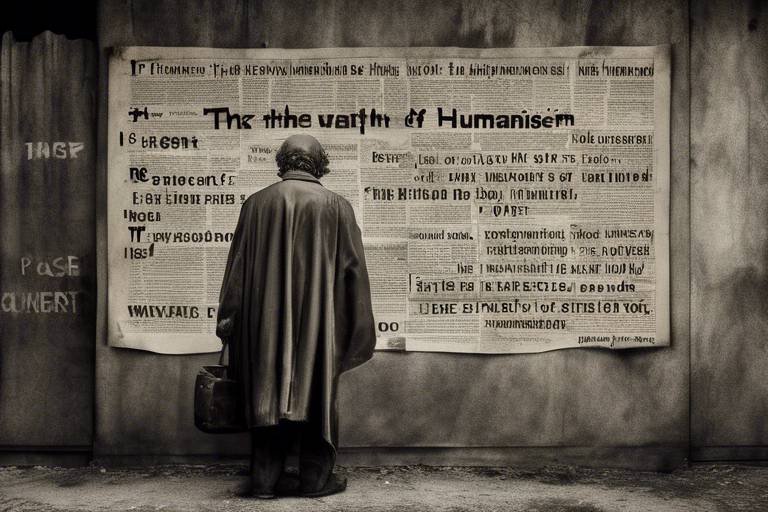Roland Barthes and the Structuralist Approach in Philosophy
Roland Barthes, a towering figure in the realm of literary theory and philosophy, has left an indelible mark on our understanding of language, meaning, and culture. His work, steeped in the principles of structuralism, invites us to reconsider how we interact with texts and the world around us. But what exactly is structuralism? In essence, it’s a framework that seeks to understand the underlying structures that govern human culture and communication. Barthes' contributions to this field are not just academic; they resonate deeply in contemporary discussions about literature and meaning.
At its core, structuralism posits that the meaning of a text is not inherent but rather constructed through a network of relationships. This idea challenges traditional notions of authorship and encourages readers to engage with texts in a dynamic way. Barthes' assertion that a text is a mosaic of quotations, a tapestry woven from the threads of other texts, highlights the interconnectedness of cultural artifacts. It's as if every piece of writing is a conversation, echoing and responding to countless voices throughout history.
Barthes' work is a clarion call for us to recognize the fluidity of meaning. He argues that texts are not static entities; instead, they are alive, breathing, and evolving with every new interpretation. This perspective not only democratizes the act of reading but also empowers individuals to find their own meanings within the text, free from the constraints of authorial intent. In this way, Barthes dismantles the traditional pedestal upon which authors have been placed, suggesting that the reader’s experience is just as vital, if not more so, than the author’s original vision.
As we delve deeper into Barthes' theories, we uncover a rich tapestry of ideas that challenge us to think critically about the world around us. His exploration of intertextuality reveals that no text exists in a vacuum; rather, each piece of writing is part of a larger conversation that spans time and culture. This interconnectedness is not merely an academic observation; it reflects the complexity of human experience, where our understanding of one idea is often shaped by the multitude of others that surround it.
In summary, Barthes' structuralist approach invites us to reconsider the role of the reader, the nature of texts, and the very fabric of culture. His insights have paved the way for new ways of thinking about literature and communication, influencing generations of thinkers and writers. As we continue to engage with Barthes' work, we find ourselves not just reading texts, but participating in an ongoing dialogue that shapes our understanding of meaning itself.
- What is structuralism? Structuralism is a theoretical framework that seeks to understand the underlying structures that govern human culture and communication.
- How does Barthes define a text? Barthes defines a text as a mosaic of quotations, emphasizing that it is interconnected with other texts and cultural artifacts.
- What is intertextuality? Intertextuality is the concept that texts are interconnected and influence each other's meanings, highlighting the relationships between different works.
- What does Barthes mean by the 'death of the author'? In his essay, Barthes argues that the author's intentions should not dictate a text's meaning, allowing readers to derive their interpretations independently.
- How has Barthes influenced contemporary literary theory? Barthes' ideas have laid the groundwork for post-structuralism and continue to resonate in modern literary and cultural studies, fostering critical discussions around meaning and interpretation.

The Foundations of Structuralism
Structuralism emerged as a significant philosophical and literary movement in the mid-20th century, fundamentally altering how we perceive language, culture, and meaning. At its core, structuralism posits that elements of human culture must be understood by way of their relationship to a broader, overarching system. This means that instead of focusing solely on individual components, structuralists analyze the structures that govern these components, revealing the underlying rules and conventions that shape our understanding of the world.
Roland Barthes, a key figure in this movement, contributed profoundly to these ideas, intertwining them with his insights on language and semiotics. Structuralism suggests that language is not merely a tool for communication but a complex system of signs that conveys meaning through its structure. Barthes' work exemplifies this notion, as he delved into how texts are constructed and how they function within cultural contexts. He believed that meaning does not reside solely within the text itself but is produced through the interplay of various elements, including the reader's interpretation and the cultural context surrounding the text.
One of the foundational principles of structuralism is the idea that meaning is relational rather than intrinsic. This means that words and symbols derive their significance from their differences and relationships to one another. For example, consider the concept of a 'tree.' The meaning of 'tree' is not defined by the word itself but by its distinction from other words like 'bush' or 'flower.' This relational understanding of meaning opens up a world of possibilities for interpretation and analysis, allowing scholars to explore how various elements interact to create complex meanings.
Barthes also emphasized the importance of language as a system of signs. He argued that every text is a network of signs that refer to other signs, creating a web of meanings that can be endlessly interpreted. This idea of intertextuality—the concept that texts are interconnected and that their meanings are shaped by their relationships with other texts—became central to Barthes' work. He believed that no text exists in isolation; rather, each text is part of a larger cultural conversation, influenced by and influencing other texts.
In summary, the foundations of structuralism lay in its relational approach to meaning, its focus on the structures that govern language and culture, and its recognition of the interconnectedness of texts. Barthes' contributions to this intellectual framework have had a lasting impact, challenging traditional notions of authorship and meaning, and paving the way for further exploration in both literary criticism and philosophy.

Barthes' Concept of Text
When we dive into Roland Barthes' concept of 'text', we are entering a vibrant world where the boundaries of meaning are not just blurred, but completely redefined. Barthes challenges the traditional notion that texts are mere vessels of meaning, arguing instead that they are dynamic entities that come alive through the interactions they foster. In his view, a text is not a solitary existence; it is a network of relationships that intertwines with other texts, creating a rich tapestry of meaning that is ever-evolving.
Barthes introduces us to the idea of intertextuality, which suggests that every text is a mosaic of references, quotations, and influences from other texts. This concept revolutionizes how we perceive literature and culture, urging us to consider not just the text itself, but the vast web of connections that surround it. Think of it like a conversation at a lively dinner party, where each guest (or text) brings their own stories, insights, and backgrounds, creating an atmosphere where meaning is collectively constructed rather than individually dictated.
At the heart of Barthes' theory is the belief that texts do not exist in isolation. Instead, they are part of a larger cultural dialogue. This interconnectedness means that the meaning of a text is shaped by its relationships with other texts, both past and present. For example, when we read a novel, we are not just engaging with its plot and characters; we are also invoking the myriad of other stories, genres, and cultural references that inform our understanding of it. This interplay is what Barthes calls intertextuality, and it opens up a world of possibilities for interpretation.
One of the most empowering aspects of Barthes' theory is his assertion that the reader plays a crucial role in the creation of meaning. Rather than being passive recipients of the author's intended message, readers actively engage with the text, bringing their own experiences, emotions, and interpretations into the mix. Barthes famously declared that the author is "dead," meaning that once a text is published, its meaning is no longer tethered to the author's intentions. Instead, it becomes a living entity, open to endless interpretations based on the reader's unique perspective. This shift places the reader at the center of the literary experience, emphasizing that meaning is not fixed but fluid, constantly reshaped by the act of reading.
In his groundbreaking essay, "The Death of the Author," Barthes argues that the focus should shift away from the author's biography and intentions to the text itself and its reception. This radical idea empowers readers, allowing them to explore the text's meanings without the constraints of authorial authority. It's akin to being given a blank canvas; readers can paint their interpretations, influenced by their personal contexts and cultural backgrounds. This liberating perspective invites a multitude of readings, making literature an ever-expanding universe of possibilities.
Barthes' concept of text, with its emphasis on intertextuality and the active role of the reader, fundamentally transforms our understanding of literature and culture. It encourages us to embrace the complexity of meaning and to appreciate the intricate web of influences that shape our interpretations. In a world where information is constantly exchanged and reinterpreted, Barthes' insights remain profoundly relevant, challenging us to think critically about the texts we engage with and the meanings we construct.

Intertextuality Explained
Intertextuality is a fascinating concept that serves as a cornerstone in Roland Barthes' work. It suggests that no text exists in a vacuum; rather, every piece of writing is interwoven with others, creating a rich tapestry of meanings. Imagine a spider web, where each strand represents a different text, connecting and influencing one another. This web-like structure of literature and language emphasizes that texts are not isolated entities but are instead part of a vast network of cultural and linguistic references.
Barthes believed that understanding intertextuality is crucial for grasping how meaning is constructed. When we read a text, we don't just interpret it based on its own words; we also consider how it relates to other texts we've encountered. For instance, when reading a novel that references Shakespeare, we bring our knowledge of Shakespeare's works into our interpretation, which can significantly alter our understanding of the new text. This interplay creates a dynamic reading experience where meaning is not static but fluid and ever-evolving.
Furthermore, Barthes argued that intertextuality challenges the notion of a singular, authoritative meaning. Instead of viewing a text as having one definitive interpretation, we recognize that meanings can shift based on various contexts and reader experiences. This perspective invites readers to engage more actively with texts, as they must navigate through the layers of connections and references that shape their understanding.
To illustrate this concept further, consider the following examples of how intertextuality operates:
- Allusions: A contemporary novel may reference classic literature, prompting readers to draw parallels and contrasts between the two works.
- Genre Blending: A film that combines elements of horror and comedy creates a dialogue between those genres, leading to new interpretations.
- Parody: A satirical piece that mimics a well-known text highlights societal norms, prompting readers to reconsider the original work's message.
In essence, intertextuality enriches our reading experience by allowing us to explore the myriad connections between texts. It encourages us to become not just passive recipients of meaning but active participants in the ongoing conversation that literature and culture engage in. By acknowledging these interconnections, we can appreciate the depth and complexity of human expression.

The Role of the Reader
When we dive into the world of literature, we often think of the author as the sole creator of meaning. However, Roland Barthes flips this notion on its head, suggesting that the reader's engagement is just as crucial, if not more so. In Barthes' view, the meaning of a text is not a fixed entity waiting to be discovered; instead, it is a dynamic construct that emerges through the reader's interaction with the text. Imagine walking into an art gallery. Each painting tells a story, but it’s your unique perspective that brings that story to life. Similarly, Barthes argues that the text is like a canvas, and the reader is the artist who colors it with their interpretations.
Barthes famously declared the "death of the author," a phrase that encapsulates his belief that an author's intentions should not confine a text's meaning. This radical idea empowers readers, allowing them to explore various interpretations without being shackled by what the author might have intended. It’s like being given a key to a treasure chest filled with countless gems of meaning. Each reader can unlock different treasures based on their own experiences, emotions, and cultural backgrounds. This opens up a world where texts can be endlessly reinterpreted, creating a tapestry of meanings that reflect the diversity of human thought.
Furthermore, Barthes emphasizes that the relationship between the reader and the text is an active one. It’s not a passive consumption of words; rather, it’s a lively dialogue. Readers bring their own contexts, histories, and biases to the table, which influence how they perceive and understand the text. This interaction can lead to a multitude of interpretations, each valid in its own right. For instance, one reader might see a novel as a love story, while another might interpret it as a critique of societal norms. This multiplicity of meanings is what makes literature a rich and vibrant field.
To illustrate Barthes' perspective, consider the following points:
- Reader as Co-Creator: The reader collaborates with the text, actively constructing meaning rather than merely receiving it.
- Diverse Interpretations: Each reader's background shapes their understanding, leading to a variety of interpretations that coexist.
- Empowerment through Engagement: Readers are encouraged to explore their interpretations, free from the constraints of the author's original intent.
In conclusion, Barthes' exploration of the reader's role in the creation of meaning challenges us to rethink how we engage with texts. It invites us to embrace our individuality as readers and recognize that our interpretations are just as significant as the words on the page. This perspective not only enriches our reading experience but also fosters a deeper appreciation for the complexities of literature and meaning.

Death of the Author
In his groundbreaking essay, "The Death of the Author," Roland Barthes challenges the traditional notion that an author's intentions and biographical context should dictate the meaning of a text. Instead, Barthes argues that once a piece of writing is published, it takes on a life of its own, becoming a playground for interpretation. This radical idea liberates texts from the constraints of authorial intent, allowing readers to engage with the work on their own terms. Imagine a painting: while the artist's brush strokes are crucial, the viewer's interpretation breathes life into the artwork, creating a dialogue that transcends the creator's original vision.
Barthes posits that meaning is not an inherent quality of the text but rather a dynamic interaction between the reader and the text itself. This perspective invites an exciting array of interpretations, as each reader brings their own experiences, emotions, and cultural backgrounds into the mix. For instance, a poem about nature could evoke feelings of nostalgia in one reader while inspiring a sense of adventure in another. The text becomes a mirror reflecting the diverse perspectives of its audience, emphasizing that meaning is fluid and ever-changing.
To illustrate Barthes' point, consider the following key ideas:
- Reader's Role: Readers are not passive recipients of meaning; they actively construct it through their engagement with the text.
- Multiplicity of Interpretations: Each reader's unique background leads to various interpretations, making a single text capable of infinite meanings.
- Authorial Intent vs. Reader Interpretation: The author's original intentions become secondary to the reader's experience, allowing for a richer and more democratic understanding of literature.
This shift in focus from author to reader not only revolutionizes literary criticism but also opens up broader discussions about the nature of culture and communication. Barthes' assertion that the author should be "dead" in the context of meaning challenges us to rethink how we engage with texts. It encourages us to appreciate literature as a collaborative act between the creator and the audience, where meaning is not a solitary destination but a journey filled with diverse paths.
Ultimately, Barthes' concept of the "Death of the Author" invites us to embrace the complexities of interpretation and the richness of human experience. It reminds us that literature is not merely a reflection of an author's mind but a vibrant tapestry woven from the threads of countless interpretations, each adding depth and color to the fabric of understanding.
1. What does Barthes mean by "Death of the Author"?
Barthes suggests that once a text is created, the author's intentions should not control its meaning. Instead, readers play a crucial role in interpreting the text based on their unique perspectives.
2. How does this concept affect literary criticism?
It shifts the focus from the author's background and intent to the reader's interpretation, allowing for a more diverse and democratic understanding of literature.
3. Can a text have multiple meanings?
Absolutely! Barthes argues that each reader brings their own experiences and emotions to a text, leading to a multitude of interpretations that can coexist.
4. Why is the reader's role important in Barthes' theory?
The reader's engagement is essential because it creates meaning. Without the reader, a text remains static and unengaged, but with interpretation, it becomes alive and dynamic.

Mythologies and Cultural Analysis
Roland Barthes' work Mythologies serves as a fascinating lens through which we can examine the intricate tapestry of everyday cultural phenomena. In this groundbreaking collection of essays, Barthes meticulously dissects various elements of popular culture, revealing the underlying myths that shape our societal values and beliefs. It’s almost like peeling back the layers of an onion; each layer exposes deeper meanings and connections that we often overlook in our daily lives.
At its core, Barthes argues that myths are not merely stories or fables; rather, they are powerful narratives that reflect and reinforce the ideologies of a culture. They can be found everywhere—advertisements, films, fashion, and even our everyday conversations. For instance, consider the myth of the “American Dream.” It encapsulates the belief that anyone, regardless of their background, can achieve success through hard work and determination. However, Barthes encourages us to critically analyze such myths, questioning their validity and the societal norms they perpetuate.
Barthes identifies several key functions of myths in culture:
- Representation: Myths represent certain values and ideals that a culture holds dear, often masking the complexities of reality.
- Normalization: They serve to normalize specific behaviors and beliefs, making them appear natural and unquestionable.
- Ideology: Myths can reflect and reinforce the dominant ideologies of a society, often serving the interests of those in power.
To illustrate his point, Barthes examines everyday objects and practices, such as the way a simple steak can symbolize masculinity and power in Western culture. Through this analysis, he reveals how such symbols are laden with cultural significance, shaping our perceptions and reinforcing societal norms. This approach not only enriches our understanding of culture but also empowers us to challenge the narratives that we often take for granted.
In essence, Barthes' Mythologies invites us to engage in a deeper cultural analysis, urging us to recognize the myths that surround us and to question their implications. By doing so, we can gain a clearer understanding of how culture operates and how it influences our beliefs and behaviors. Barthes' work remains incredibly relevant today, as we navigate a world filled with complex narratives and competing ideologies.
1. What is the main idea behind Barthes' concept of myths?
Barthes argues that myths are narratives that shape cultural beliefs and values, often masking the complexities of reality and reinforcing dominant ideologies.
2. How does Barthes analyze everyday cultural phenomena?
In Mythologies, Barthes dissects various cultural elements, such as advertisements and fashion, to reveal the underlying myths that influence societal norms and perceptions.
3. Why is Barthes' work still relevant today?
Barthes' insights into cultural analysis encourage critical thinking about the narratives that shape our beliefs and behaviors, making his work applicable to contemporary discussions about culture and ideology.

Mythologies
In his groundbreaking work , Roland Barthes delves deep into the fabric of everyday life, peeling back the layers of meaning that saturate our cultural experiences. He explores how seemingly mundane objects, rituals, and practices are imbued with profound significance, transforming them into powerful myths that shape societal values and beliefs. Barthes argues that these myths are not merely relics of the past but are actively constructed and maintained through language and culture, influencing our perceptions of reality. This perspective invites us to reconsider the world around us, recognizing that what we often take for granted is steeped in cultural narratives that dictate our understanding of self and society.
Barthes identifies various cultural phenomena, from advertisements to fashion, and examines how they serve as vehicles for broader ideological messages. For instance, he discusses how the depiction of the French wrestling match in popular media can be interpreted as a reflection of societal norms and expectations. By dissecting these representations, Barthes reveals the underlying structures of power and ideology that inform our daily lives. This analysis encourages us to question the status quo and consider how myths operate in our own contexts. After all, what we consume—be it media, fashion, or even language—carries with it a weight of cultural significance that often goes unnoticed.
To illustrate his point, Barthes categorizes myths into several key themes, each reflecting different aspects of human experience. Here’s a brief overview of some of these themes:
| Theme | Description |
|---|---|
| Nature | How natural elements are mythologized to convey cultural ideals. |
| Heroism | The glorification of certain figures or actions that embody cultural values. |
| Consumerism | The relationship between consumer goods and identity formation. |
| Tradition | How historical narratives shape contemporary beliefs and practices. |
By exposing the mechanisms of myth-making, Barthes empowers individuals to critically engage with the cultural narratives that surround them. He posits that understanding these myths is essential for recognizing the ways in which they influence our thoughts, actions, and identities. In essence, Barthes invites us to become active participants in the cultural dialogue, urging us to question the myths we encounter daily and to seek deeper meanings behind the surface.
- What is the main idea behind Barthes' Mythologies?
Barthes' Mythologies explores how everyday cultural phenomena are imbued with deeper meanings and how these myths shape societal values and beliefs. - How does Barthes define a myth?
Barthes defines a myth as a system of communication that conveys cultural meanings, often obscuring the underlying ideologies at play. - What relevance does Mythologies have today?
Barthes' analysis remains relevant as it encourages critical engagement with contemporary cultural narratives and the ideologies they perpetuate.

examines everyday cultural phenomena, revealing how myths shape societal values and beliefs, thus providing insight into the relationship between culture and ideology.
This article explores Roland Barthes' contributions to structuralism, examining his theories on language, meaning, and culture, and their profound impact on contemporary philosophy and literary criticism.
An overview of structuralism as a philosophical and literary movement, highlighting its key principles and how Barthes' work fits into this intellectual framework.
Exploring Barthes' definition of 'text,' this section delves into his views on intertextuality and how texts generate meaning through their relationships with other texts.
Intertextuality is a core concept in Barthes' work, emphasizing that texts do not exist in isolation but are interconnected, influencing and shaping each other's meanings.
Barthes argues that readers play a crucial role in interpreting texts, suggesting that meaning is not fixed but rather created through the reader's engagement with the text.
In his famous essay, Barthes posits that the author's intentions should not dictate a text's meaning, empowering readers to derive their interpretations independent of authorial influence.
Barthes' work Mythologies examines everyday cultural phenomena, revealing how myths shape societal values and beliefs, thus providing insight into the relationship between culture and ideology. He delves into the mundane aspects of life—advertisements, fashion, and even food—demonstrating that these elements are not just trivial but are imbued with deeper meanings that reflect and reinforce societal norms. For instance, when we consider the portrayal of food in media, Barthes argues that it transcends mere sustenance; it becomes a symbol of cultural identity and aspiration.
To illustrate this, Barthes identifies various myths that permeate everyday life:
- The Myth of the Hero: This myth glorifies individualism and success, shaping societal expectations of what it means to achieve greatness.
- The Myth of Love: Often romanticized in literature and film, this myth influences how relationships are perceived and valued in society.
- The Myth of the Family: This myth presents an idealized version of family life that can create unrealistic expectations and pressures.
By dissecting these myths, Barthes encourages us to question the ideologies they promote and recognize how they impact our beliefs and behaviors. He suggests that understanding these cultural narratives allows us to see beyond the surface and appreciate the complexities of human experience. In doing so, Barthes not only critiques the myths themselves but also empowers individuals to redefine their own narratives within a cultural context.
This section discusses Barthes' legacy in literary criticism, focusing on how his ideas have influenced post-structuralism and contemporary theories of literature and meaning.
Barthes' contributions laid the groundwork for post-structuralist thought, challenging fixed meanings and encouraging a more fluid understanding of texts and their interpretations.
Barthes' theories continue to resonate in modern literary and cultural studies, fostering critical discussions around meaning, interpretation, and the role of culture in shaping human experience.
- What is structuralism?
- Structuralism is a theoretical framework that seeks to understand the underlying structures that govern human culture, language, and thought.
- How did Barthes influence literary criticism?
- Barthes challenged traditional notions of authorship and meaning, paving the way for new interpretations of texts that consider the reader's role in creating meaning.
- What is intertextuality?
- Intertextuality refers to the relationship between texts and how they reference or influence each other, suggesting that no text exists in isolation.

The Impact of Barthes on Literary Theory
Roland Barthes was nothing short of a revolutionary figure in the realm of literary theory. His ideas have not only transformed the way we interpret texts but have also paved the way for a deeper understanding of culture and meaning. Barthes’ approach encourages readers to engage with literature in a dynamic manner, pushing the boundaries of traditional literary criticism. His legacy is profound, and its ripples can still be felt in contemporary discussions around literature and its interpretation.
One of Barthes' most significant contributions is the notion that texts are not static entities with fixed meanings. Instead, he proposed that meaning is fluid and constructed through the interaction between the text and the reader. This radical shift in perspective has led to a re-evaluation of the role of the author, the reader, and the text itself. In Barthes’ view, the author’s intention should not be the sole determinant of a text’s meaning. This idea culminated in his famous declaration of the “Death of the Author,” which has become a cornerstone of modern literary theory.
Barthes’ influence extends beyond just literary criticism; it has also impacted various fields such as cultural studies, semiotics, and philosophy. His work has encouraged scholars to explore the relationships between texts and the broader cultural contexts in which they exist. For instance, his analysis of myths in everyday culture, as seen in his work Mythologies, demonstrates how cultural narratives shape societal values and beliefs. This approach has inspired a generation of thinkers to consider how texts reflect and construct cultural identities.
Moreover, Barthes’ ideas have laid the groundwork for post-structuralism, a movement that challenges the idea of fixed meanings and embraces ambiguity. Post-structuralist theorists, influenced by Barthes, argue that texts can be interpreted in multiple ways, allowing for a richer and more diverse understanding of literature. This shift has opened up new avenues for literary analysis, encouraging scholars to examine how different interpretations can coexist and how cultural contexts influence these readings.
In summary, the impact of Roland Barthes on literary theory is monumental. His ideas have not only reshaped the way we approach texts but have also fostered a critical dialogue about the nature of meaning itself. As we continue to engage with literature in increasingly complex ways, Barthes’ contributions remind us of the importance of the reader’s role in the creation of meaning. His legacy serves as a guiding light for those navigating the intricate web of language, culture, and interpretation.
- What is the main idea behind Barthes' "Death of the Author"?
Barthes argues that the author's intentions should not dictate a text's meaning, allowing readers to derive their interpretations independently.
- How did Barthes influence post-structuralism?
His ideas challenged fixed meanings and encouraged a more fluid understanding of texts and their interpretations, which became foundational for post-structuralist thought.
- What is intertextuality in Barthes' work?
Intertextuality refers to the interconnectedness of texts, suggesting that no text exists in isolation and that meanings are shaped by their relationships with other texts.

Post-Structuralism and Beyond
Roland Barthes' contributions to the field of literary theory did not merely stop at structuralism; they paved the way for what we now refer to as post-structuralism. This intellectual movement emerged as a response to the limitations of structuralism, particularly its tendency to fix meanings and establish rigid interpretations of texts. Barthes was instrumental in this shift, advocating for a more fluid understanding of language and meaning that acknowledges the complexities and ambiguities inherent in both texts and their interpretations.
At the heart of post-structuralist thought is the idea that meaning is not static; rather, it is a dynamic interplay of signs, contexts, and interpretations. Barthes argued that a text is not a closed system with a single, authoritative meaning. Instead, it is an open field where multiple interpretations can coexist, shaped by the cultural and historical contexts in which they are read. This perspective encourages readers to engage actively with texts, allowing them to draw their own conclusions and interpretations rather than relying solely on the author's intent.
Barthes famously stated that "the author is dead," a provocative assertion that challenges traditional notions of authorship and authority in literary criticism. By declaring the death of the author, Barthes emphasized that the reader's experience and interpretation of a text are just as vital—if not more so—than the author's original intentions. This democratization of meaning has profound implications for literary analysis, as it invites a diverse range of voices and perspectives into the conversation.
Moreover, Barthes' work has influenced various fields beyond literature, including cultural studies, philosophy, and semiotics. His ideas have encouraged scholars to explore the relationships between texts and the broader cultural narratives that shape our understanding of the world. This exploration often involves examining how power dynamics, ideologies, and societal norms manifest within texts, revealing the complex ways in which culture and meaning intersect.
In contemporary discourse, Barthes' influence can be seen in various theoretical frameworks that prioritize the reader's role in the construction of meaning. For instance, feminist, postcolonial, and queer theories have all drawn on Barthes' insights to challenge dominant narratives and highlight marginalized voices. This approach underscores the importance of context in interpreting texts, as different readers bring their unique experiences and perspectives to the table.
In summary, Barthes' legacy in post-structuralism is not just about challenging established norms; it is about embracing the richness of interpretation and the multiplicity of meanings that texts can generate. His work continues to inspire critical thought and discussion, urging us to question our assumptions about literature, culture, and the very nature of meaning itself.
- What is the main difference between structuralism and post-structuralism?
Structuralism seeks to identify underlying structures in texts and establish fixed meanings, while post-structuralism argues that meanings are fluid and shaped by cultural and contextual factors. - How did Barthes influence modern literary criticism?
Barthes' emphasis on the reader's role in interpreting texts has led to a more inclusive and diverse approach to literary analysis, allowing for multiple interpretations and voices. - What does Barthes mean by "the death of the author"?
This phrase suggests that an author's intentions should not dictate a text's meaning, empowering readers to derive their interpretations independently.

Contemporary Relevance
Roland Barthes' theories are not just relics of the past; they continue to reverberate through the corridors of modern literary and cultural studies. In today's world, where the lines between authors, texts, and readers are increasingly blurred, Barthes' ideas provide a critical lens through which we can examine the complexities of meaning and interpretation. His assertion that meaning is fluid and dependent on context resonates deeply in a society that is constantly evolving and reshaping its values.
For instance, consider how social media platforms have transformed the way we consume and interpret texts. In this digital age, a tweet or an Instagram post can be seen as a 'text' that interacts with countless other texts, creating a web of meanings that shift with every new interaction. Barthes' concept of intertextuality becomes particularly relevant here, as it highlights the interconnectedness of content across various media. Every meme, every viral video, and every shared article is part of a larger dialogue that influences our understanding of culture and society.
Moreover, Barthes' provocative notion of the “Death of the Author” challenges us to rethink who holds the power in the interpretation of texts. In our current cultural landscape, where multiple voices vie for attention, the idea that a reader's interpretation can be as valid as the author's intention empowers individuals to engage with texts in a more personal and meaningful way. This democratization of interpretation encourages a diverse range of perspectives, enriching our understanding of literature and culture.
To illustrate Barthes' contemporary relevance, let’s look at a few key areas where his ideas have made a significant impact:
- Literary Criticism: Barthes has paved the way for critics to explore texts without being tethered to authorial intent, allowing for a broader range of interpretations.
- Cultural Studies: His analysis in works like Mythologies encourages us to scrutinize everyday cultural phenomena and understand how they shape our beliefs and values.
- Digital Media: The rise of the internet has created a landscape where texts are constantly recontextualized, echoing Barthes' ideas about intertextuality.
In conclusion, Roland Barthes' contributions to the understanding of text, meaning, and culture are as relevant today as they were during his lifetime. His theories invite us to engage critically with the world around us, encouraging a mindset that embraces ambiguity and celebrates the multiplicity of interpretations. As we navigate an increasingly complex cultural landscape, Barthes reminds us that the act of reading is not merely a passive consumption of information but an active, dynamic process that shapes our reality.
- What is the significance of Roland Barthes in literary theory?
Barthes is significant for his contributions to structuralism and post-structuralism, particularly his ideas on intertextuality and the role of the reader in creating meaning. - How does Barthes' "Death of the Author" impact literary interpretation?
This concept shifts the focus from the author's intentions to the reader's engagement, allowing for multiple interpretations of a text. - Why is intertextuality important in contemporary culture?
Intertextuality underscores the interconnectedness of texts in our digital age, where meanings are constantly negotiated and reshaped through various media.
Frequently Asked Questions
- What is structuralism in philosophy?
Structuralism is a theoretical framework that emphasizes the underlying structures that shape culture, language, and human behavior. It suggests that elements of human culture must be understood in relation to a larger, overarching system of relationships.
- How did Roland Barthes contribute to structuralism?
Roland Barthes was pivotal in developing structuralist thought, particularly through his analysis of texts and their meanings. He introduced concepts like intertextuality and the idea that meaning is created through the relationship between texts, rather than being inherent to any single text.
- What does Barthes mean by 'the death of the author'?
In his essay "The Death of the Author," Barthes argues that an author's intentions and background should not dictate the interpretation of a text. Instead, he believes that readers should have the freedom to derive their own meanings, making the text a more dynamic and interactive experience.
- What is intertextuality according to Barthes?
Intertextuality refers to the interconnectedness of texts, where the meaning of one text is influenced by its relationship to other texts. Barthes posits that no text exists in isolation; rather, it is part of a web of cultural and literary references that shape its interpretation.
- How does Barthes' work relate to contemporary literary criticism?
Barthes' theories have significantly influenced contemporary literary criticism by encouraging a more fluid understanding of texts. His ideas challenge traditional notions of fixed meanings, promoting discussions around interpretation and the role of culture in shaping our understanding of literature.
- What are Barthes' 'Mythologies' and their significance?
In "Mythologies," Barthes analyzes everyday cultural phenomena and how they embody societal myths. He reveals the ways in which these myths shape our beliefs and values, providing insight into the relationship between culture and ideology.
- Why is Barthes considered a key figure in post-structuralism?
Barthes is seen as a key figure in post-structuralism because his work laid the groundwork for questioning fixed meanings in texts. His emphasis on the reader's role in creating meaning and the fluidity of interpretation aligns closely with post-structuralist thought.
- What is the relevance of Barthes' theories today?
Barthes' theories remain highly relevant in modern literary and cultural studies. They foster critical discussions around meaning, interpretation, and the impact of culture on human experience, making his work a cornerstone of contemporary analysis.



















